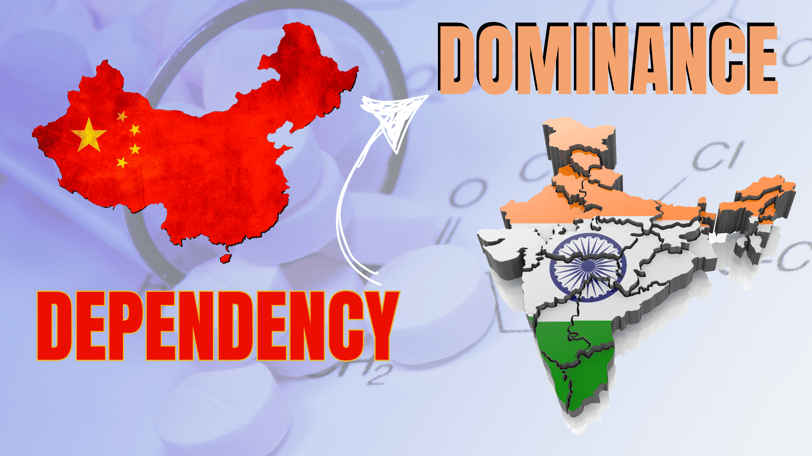From Dependency to Dominance: How India is Redefining Its Pharma Supply Chain
Discover how India is transforming its pharma supply chain, reducing dependence on China through innovation, local manufacturing, and strategic policies. Explore the journey toward self-reliance and global leadership in pharmaceutical production.
1/4/20253 min read


From Dependency to Dominance: How India is Redefining Its Pharma Supply Chain
India, often hailed as the "Pharmacy of the World," has played a pivotal role in global healthcare by supplying affordable generic drugs to over 200 countries. Yet, this remarkable achievement has long been shadowed by a significant dependency on China for active pharmaceutical ingredients (APIs) and key starting materials (KSMs). This reliance, accounting for over 60% of India's API imports, has posed strategic, economic, and geopolitical risks.
However, recent years have marked a paradigm shift in India's pharmaceutical supply chain. The country is making bold strides to transition from dependency to dominance, driven by lessons from the COVID-19 pandemic, government initiatives, and industry innovation. Clavulanic acid, penicillin, ciprofloxacin, clarithromycin, and prednisolone are APIs that India is significantly advancing in production, with the country emerging as a major producer rather than relying on imports from China.
The Problem: Overdependence on China
The pandemic exposed the vulnerabilities of India's pharma industry. Supply chain disruptions from China highlighted the risks of overreliance on a single source for critical raw materials. This dependence not only threatened India's drug production but also raised questions about long-term sustainability and resilience.
The root cause of this dependency lies in the cost competitiveness of Chinese manufacturers, who dominate the global API market. Indian firms often found it challenging to match these prices while maintaining profitability, leading to a steady decline in domestic API production over the years.
The Response: Government Interventions
Recognizing the urgency of the situation, the Indian government launched several initiatives to reduce reliance on imports and bolster local manufacturing:
Production-Linked Incentive (PLI) Scheme:
Introduced in 2020, the PLI scheme aims to incentivize domestic manufacturing of APIs, KSMs, and drug intermediates. By offering financial benefits to manufacturers, the program seeks to revive India's API industry and attract significant investments.Bulk Drug Parks:
The government has proposed establishing bulk drug parks with world-class infrastructure to support API manufacturing. These parks aim to provide cost-effective production facilities, enabling Indian firms to compete globally.Ease of Doing Business:
Policy reforms, such as streamlined approval processes and financial incentives, have been introduced to encourage investments in the pharma sector.
The Industry's Role: Embracing Innovation
Leading Indian pharmaceutical companies are stepping up to the challenge. Firms like Aurobindo Pharma, Sun Pharma, and Dr. Reddy's Laboratories have begun diversifying their supply chains and investing in local API production facilities. Additionally, the industry is exploring advanced manufacturing technologies, such as green chemistry and continuous manufacturing, to enhance efficiency and reduce costs.
The Shift: The "China Plus One" Strategy
An essential aspect of this transformation is the implementation of the "China Plus One" strategy, where Indian pharmaceutical companies are broadening their sourcing options by forming partnerships with other countries and simultaneously strengthening domestic production capabilities. This approach mitigates risks associated with geopolitical tensions and supply chain disruptions, ensuring a more resilient system.
Challenges on the Road to Dominance
While progress is evident, achieving self-reliance in pharma manufacturing is not without challenges:
Cost Competitiveness: Chinese imports remain significantly cheaper, making it difficult for Indian manufacturers to compete.
Technological Gaps: Advanced technologies and expertise are needed to produce high-quality APIs at scale.
Investment Requirements: Scaling up local production demands substantial financial investment and infrastructure development.
The Path Forward
To truly dominate the global pharmaceutical landscape, India must adopt a multi-pronged strategy:
Enhanced R&D Investments: Focusing on research and development can drive innovation and reduce production costs.
Global Collaborations: Partnering with international firms can facilitate knowledge transfer and technology sharing.
Policy Support: Continued government support through incentives and subsidies is essential for sustained growth.
Conclusion
India's journey from dependency to dominance in the pharma supply chain is a story of resilience, innovation, and strategic foresight. By leveraging its strengths and addressing existing challenges, India is well-positioned to not only reduce its reliance on imports but also emerge as a global leader in pharmaceutical manufacturing.
This transformation is not just about achieving self-reliance—it is about redefining India's role in the global healthcare ecosystem, ensuring affordable and accessible medicines for all.
